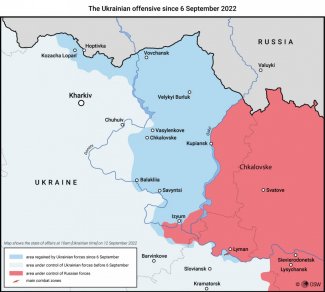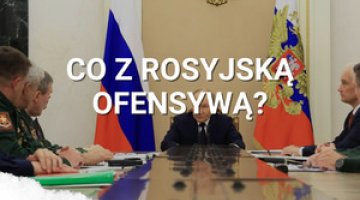Ukrainians retake Kharkiv Oblast. 200 days of war

As a result of the continuation of the advance in the Kharkiv Oblast, Ukrainian units have seized, among others, Kupansk, the junction town of Savyntsi, located between Balakliia and Izyum, and Izyum itself (although this has not yet been officially confirmed by the Ukrainian side). There is no confirmation of reports that part of the Russian grouping south of the latter town failed to withdraw and was locked in a cauldron. The Ukrainians extended their theatre of operations to the northeast of the Kharkiv Oblast, striking east of Chuhuiv and crossing the Donets River (Vasylenkove and Artemivka were seized on 10 September and, according to some sources, Vovchansk near the Russian border, which had previously been abandoned by the Russians). Operations in the Kharkiv Oblast were accompanied by a shift to the offensive northeast of Sloviansk, with fighting taking place in the vicinity of Lyman. Ukrainian saboteurs in the northwest of the Luhansk Oblast have also become active.
On 11 September, the Ministry of Defence of the Russian Federation announced the complete withdrawal of Russian forces from the occupied areas of the Kharkiv Oblast except for a narrow strip on the eastern side of the Oskil River (along the border with the Luhansk Oblast). On the same day, there were reports of Ukrainian troops occupying towns north and east of Kharkiv (Kozacha Lopan’, Velykyi Burluk), near Chuhuiv (Chkalovs’ke) and near the border with Russia (Hoptivka and, according to some sources, Vovchansk). The General Staff of the Ukrainian army also reported that Russian forces attempted an attack on 11 September in the area of the town of Velyki Prokhody, north of Kharkiv. Between 6 and 11 September, Ukrainian forces were to regain control of more than 50 localities, while occupying an area of some 3,000 km², and the incursion into previously occupied territory reached a depth of 70 km.
On the other directions of operations, the situation has not changed and the arena of the heaviest fighting remains the Donbas. Russian forces unsuccessfully attacked Bakhmut from the east and Ukrainian positions around the city. Fighting continues to take place to the southeast and south of Bakhmut. Fighting also occurred on the outskirts of Gorlovka, in and north of the Avdiivka area and west of Donetsk. In the Kherson Oblast, Russian forces were to abandon some of the towns they had previously occupied, while on the other hand, they are strengthening the defences of Kherson and bringing additional units to the city. They also began work to resume movement across the bridge over the Kakhovka Hydroelectric Power Plant dam. After the ineffective attacks carried out on 9 September in the Bezimenne area, in the following days the Russians made no attempt to break through the Ukrainian defences. According to local reports, the invaders are also said to be reinforcing their forces in the Zaporizhzhia Oblast, directing additional units from Mariupol towards the front line.
Russian artillery and air power have not ceased their attacks on Ukrainian army positions and facilities along the entire line of contact (including in the newly lost areas of the Kharkiv Oblast) and in the border areas of the Sumy Oblast. Outside the immediate combat areas, Kharkiv remained the main target, with the bombardment of the city intensifying as Ukrainian forces advanced in the Kharkiv Oblast. On 11 September, a local thermal power station (TEC-5) was attacked, and some high-voltage transmission lines were also destroyed, resulting in the temporary suspension of energy and heat supplies across several districts. Mykolaiv, Nikopol, Kramatorsk, Sloviansk, Zaporizhzhia and many smaller towns in Kharkiv, Donetsk and Mykolaiv oblasts, in the south of Dnipropetrovsk Oblast and in the northern part of Zaporizhzhia Oblast were also shelled and bombed. On 9–11 September, 47 missile attacks took place (some rockets were shot down), in which the city of Dnipro, Nova Vodolaha in the Kharkiv Oblast, Pokrovsk in the Donetsk Oblast, Voznesens’k in the Mykolaiv Oblast and targets in the region of Human and Kremenchuk were affected. Ukrainian artillery and aviation attacked mainly targets in Kherson Oblast, including the ferry crossing at L’vove near Nova Kakhovka. According to the Ukrainian General Staff, enemy aviation activity increased.
The advances of the Ukrainian troops are accompanied by a high level of activity by sabotage groups in the rear of the Russian forces. This makes the aggressor’s security forces nervous and increases repression. In a 9 September communiqué, the Russian National Guard admitted that 73 people suspected of collaborating with the Ukrainian army and the Ukrainian Security Service had been detained in the Kherson and Zaporizhzhia oblasts during the week. Eleven caches of weapons and ammunition were revealed, and portable anti-tank and anti-aircraft missile launchers NLAW, MANPADS and Igla were confiscated. Ukrainian special forces also operate on Russian territory. On the night of 9–10 September, a clash took place in the area of the town of Sudzha, in the Kursk Oblast, 9 km from the border with Ukraine, with a patrol of the Russian National Guard combing the surrounding forests. The Russian authorities confirmed that the attack was carried out by four saboteurs who wounded one soldier. The governor of the Kursk Oblast said that operational and search operations were still underway and urged residents to remain vigilant.
An important effect of the Ukrainian offensive is the disorganisation of preparations for ‘annexation referendums’ in the occupied territories. It is now no longer possible to hold them in the Kharkiv Oblast, and unlikely in the Kherson and Zaporizhzhia oblasts. The activity of the Ukrainian army has created a mood of panic among the collaborators, effectively paralysing the Russian-initiated so-called election campaign. The occupiers themselves have given up on indicating a specific date for referendums, and the functioning of the collaborationist administration is becoming increasingly façade-like. In the temporarily occupied territories of the Kherson Oblast, the Russians strengthened the administrative-police regime, introducing a ban on movement between villages. Residents of Nova Kakhovka and Kozats’ke were warned that approaching the Dnieper crossing would be met with opening fire without warning. In the Kherson Oblast, on the other hand, the collaborationist ‘military-civilian administration’ called on all residents to evacuate to Russia.
Confirmation of the well-planned Ukrainian offensive is provided not only by the successive victories, but also by the immediate measures taken to influence the security situation in the occupied localities. In the areas recaptured from the hands of the enemy, the police and SBU, on the basis of previously collected materials, search for persons suspected of collaboration. These actions are part of a preventive-psychological operation to make collaborators aware that their activities are being constantly monitored and that the evidence collected will be used to bring criminal charges.
The atmosphere of excessive euphoria prevailing in Ukrainian social networks with unconfirmed information about the seizure of more towns (including Donetsk airport) has been cooled by the Ukrainian defence ministry. Deputy Defence Minister Hanna Malar called for unverified reports about the liberation of more towns not to be published. She stressed that in many towns, considered liberated, heavy fighting is in fact still going on.
The success of the Ukrainian offensive and the accompanying flood of information highlighting the Russian defeat took the Russian defence ministry by surprise by monopolising official coverage of the situation on the front. It was only on 10 September that it decided to issue a perfunctory communiqué stating that ‘an operation to regroup troops in the Izyum and Balakliia Raions was carried out within three days’. The attempt to promote the thesis that Ukrainian troops had entered an area previously abandoned by the Russians on a planned basis failed. Its ludicrousness became the subject of derision on social networks and was used to discredit the Russian military. To limit the negative effects of its own information policy, the Russian defence ministry is attempting to impose censorship on social media, preventing unfavourable comments from being posted on accounts it controls.
The successful counter-offensive is being used by the Ukrainian authorities to convince Western partners to increase the supply of military aid. In a statement published on 10 September, a spokesman for the Ukrainian Foreign Ministry said that the military successes were the result of a combination of the bravery of Ukrainian soldiers and Western military support. In this regard, he called on partners to continue the delivery of military aid to help bring about peace more quickly. According to Defence Minister Oleksii Reznikov, a successful offensive by Ukrainian troops will be an important argument to convince Western politicians to increase military support.
The Ukrainian defence ministry chief’s words were confirmed by a previously unannounced visit to Kyiv by Minister Annalena Baerbock on 10 September. The head of German diplomacy said that the changing situation on the frontline made it necessary to ‘analyse Germany’s assistance so far’ and the way forward. Baerbock confirmed that Berlin would ‘stand together with Ukraine for as long as needed’, supporting Kyiv with arms supplies, humanitarian and financial aid. In an interview published on 11 September, German Ambassador to Kyiv Anka Feldhusen admitted that ‘politicians in Berlin are delighted with the Ukrainian military offensive’.
During a speech on 10 September, President Volodymyr Zelensky assessed that ‘the Russian side is currently incapable of adequately formulating its position and therefore talks on ending the war are impossible’. In turn, Foreign Minister Dmytro Kuleba stated that the best place to hold talks with Putin is on the battlefield. Zelensky also announced that due to the energy blackmail applied to Ukraine and Europe, the upcoming winter will be decisive for Ukraine. ‘The next 90 days will decide more than 30 years of Ukrainian independence,’ he said, calling on the democratic world to ‘completely isolate the state and Russian citizens’ and ‘systematically supply weapons to Ukraine’.
In response to the Russian army’s rocket fire on critical energy infrastructure in Ukraine, President Zelensky published an emotional statement calling the attacks deliberate and cynical acts of terrorism by Russia. He decried the Kremlin’s inability to intimidate or break the resistance of Ukrainians and that even a lack of water, light, gas and water would not force Kyiv to make any concessions to Moscow: ‘Cold, hunger, darkness and thirst are not as terrible and deadly as Russian ‘friendship and brotherhood’’.
Commentary
- The Ukrainian offensive towards Kupansk evolved over several days into an offensive conducted in several directions in the Kharkiv Oblast and in the Donetsk Oblast northeast of Sloviansk. The forces of the defenders sought first to cut off from the hinterland and then to encircle the Russian grouping on the border of the Kharkiv and Donetsk oblasts, thus freeing the latter from the threat from the north. As a result of the operations carried out, not only was the threat removed from Sloviansk and Kramatorsk, but also almost all of the occupied lands of the Kharkiv Oblast (except for the eastern bank of the Oskil River) were liberated. Fearing encirclement and destruction by Ukrainian forces, the Russians rolled back one of the four directions of attack on the defenders’ positions in the Donetsk Oblast (the aggressor was left with groupings operating from the east from the Luhansk Oblast, from the Donetsk Oblast and from the Mariupol region in the south).
- The offensive in the Kharkiv Oblast is the first move by the Ukrainian army since 24 February by which it has taken the initiative on an operational scale, and represents the first achievement of this scale since the beginning of the war. It is also the first success that can be described as allied – staff decisions were worked out on the basis of US reconnaissance data, and the main breakthrough force was provided by tanks received from Poland.
- Russian forces appeared completely unprepared to defend their main supply line in the Kharkiv Oblast (Valuyki–Kupansk–Izyum). Whether they were unable to properly recognise the preparations on the Ukrainian side or ignored reports of the formation of a strike grouping between Chuhuiv and Balakliia, there was a blunder. The development of the situation between 6 and 12 September indicates that the Russians failed to properly secure such a sensitive section – the only line of defence was manned by Rosgvardiya units and secondary subunits of the so-called Luhansk People’s Militia (by comparison: the three lines of defence in the Kherson and Zaporizhzhia oblasts are manned by regular formations of the Russian army). Nor did they prepare reserves with which they could support the retreating troops at short notice and stop the enemy’s advance. Moreover – in the run-up to the Ukrainian strike, the Russians withdrew some units and directed them to reinforce the grouping in the Kherson Oblast. Even a relatively rapid build-up of forces by the aggressor, with which it would be able to launch an effective counter-attack and regain control of the previously occupied area (which is unlikely), will no longer change the fact that the Russians lost an important battle and lost the initiative for the first time since 24 February.
- The continuation of the Ukrainian army’s offensive towards the Donbass will depend on the further attitude of the enemy. The withdrawal of Russian troops from most of the Kharkiv Oblast, occupied so far, paradoxically hinders further action by the defenders, who have shifted from driving the enemy out militarily to seizing more of the towns abandoned by them without a fight. Both this and the need to work out further operational plans give the Russians time to prepare a counter-offensive or consolidate in new positions. The actions in the Lyman area indicate that Russian forces are capable of mounting effective resistance, even if they – as the attacking side – have not previously prepared a defence line in a given direction. However, given the euphoria surrounding the liberation of the part of Ukraine that has been occupied since the end of February, and the consequent increase in motivation to continue fighting, a more serious challenge for the Ukrainian forces will be to ensure that adequate quantities of arms, ammunition and war material from the West are available for further operations.
- The Ukrainian offensive has called into question the efficiency and effectiveness of Russian military reconnaissance and intelligence activities carried out by military intelligence and the FSB. The lack of a rapid response from the Russian side to the Ukrainian military advances makes the thesis of a high degree of compartmentalisation and ineptitude among the command staff of the Russian Armed Forces plausible. The territory occupied by the Ukrainians was not prepared for defence, nor were there forces capable of repelling an attack on important communication nodes for logistical support of their own forces. The rapid withdrawal of units, referred to by the Russians as ‘regrouping’, was intended to limit excessive losses in manpower and equipment. It was often done in a panicky manner (significant amounts of abandoned heavy equipment and ammunition were seized), reflecting the low morale of Russian soldiers fighting a highly motivated enemy. The loss of significant territory did not so much undermine the image of the Russian army as question its ability to plan a military operation and anticipate the Ukrainian army’s moves.
- The non-military costs to Russia of the defenders’ offensive are far greater than the mere fact of losing part of the territory previously occupied. They create serious political and image problems for the Kremlin. The successful attack by Ukrainian troops has devastated the Russian propaganda message about the gradual successes of the ‘special operation’ and its imminent completion. It also disorganised preparations for the so-called annexation referendums and significantly hampered their planned holding in the autumn, in addition to causing panic among collaborators and deconstructing the narrative of the ‘eternal’ belonging of the occupied territories to the Russian state. There is growing criticism in Russia questioning the way the ‘special operation’ was commanded.
- The Russian attack, which led to a power outage in several oblasts, shows how vulnerable Ukraine’s critical infrastructure is under conditions of inadequate missile defence. Although power transmission was restored in most areas within hours, there is currently no detailed information on the extent of the damage. What is known is that heating plant No. 5 in Kharkiv, which supplies heat to about 25 per cent of the city and region’s population, was severely damaged. Repeated attacks, which are also very likely in the near future, could lead to heating disruptions in some cities, especially in the eastern part of the country, with dire consequences for the population in the coming winter.
Map. The Ukrainian offensive since 6 September 2022






